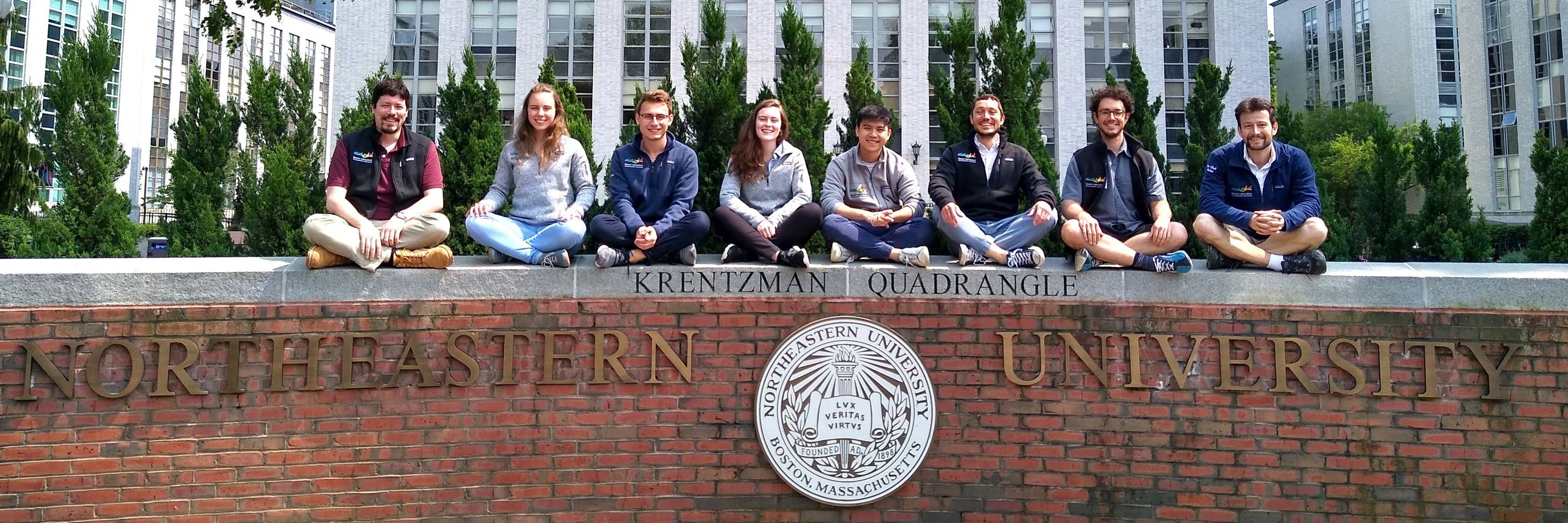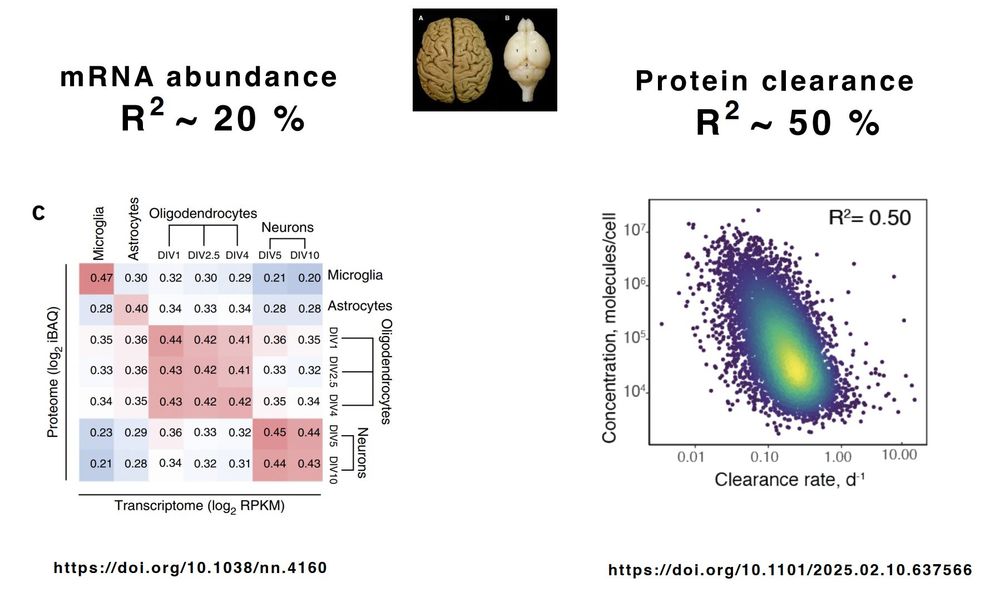
https://nikolai.slavovlab.net

2/n
youtu.be/nIB-WjWzDSc?...
⬛️ Their abundance strongly declines in AD patients.
=> This decline parallels a reduction in 20S substrate proteins and leads to abnormal protein accumulation in AD.
www.biorxiv.org/content/10.1...

⬛️ Their abundance strongly declines in AD patients.
=> This decline parallels a reduction in 20S substrate proteins and leads to abnormal protein accumulation in AD.
www.biorxiv.org/content/10.1...
The brain proteome is highly sculpted by protein degradation.
Why ?
This is our model: biorxiv.org/content/10.1...

The brain proteome is highly sculpted by protein degradation.
Why ?
This is our model: biorxiv.org/content/10.1...
In the absence of obvious physical sensing organs like lenses, how do plants work out the precise direction from which light is coming ?
In the absence of obvious physical sensing organs like lenses, how do plants work out the precise direction from which light is coming ?
Yet, studies show there’s only so much protein the body can use.

Yet, studies show there’s only so much protein the body can use.
𝐓𝐡𝐞 𝐬𝐢𝐦𝐩𝐥𝐞𝐬𝐭 𝐞𝐱𝐩𝐥𝐚𝐧𝐚𝐭𝐢𝐨𝐧 𝐢𝐬𝐧’𝐭 𝐚𝐥𝐰𝐚𝐲𝐬 𝐭𝐡𝐞 𝐛𝐞𝐬𝐭 𝐨𝐧𝐞.
1/n

𝐓𝐡𝐞 𝐬𝐢𝐦𝐩𝐥𝐞𝐬𝐭 𝐞𝐱𝐩𝐥𝐚𝐧𝐚𝐭𝐢𝐨𝐧 𝐢𝐬𝐧’𝐭 𝐚𝐥𝐰𝐚𝐲𝐬 𝐭𝐡𝐞 𝐛𝐞𝐬𝐭 𝐨𝐧𝐞.
1/n
Even if spectacularly successful, they leave open key questions:
◾️Functions of genetic mutations & polymorphisms
◾️Proteoform functions
◾️Protein abundance regulation
Biology is complex.

Even if spectacularly successful, they leave open key questions:
◾️Functions of genetic mutations & polymorphisms
◾️Proteoform functions
◾️Protein abundance regulation
Biology is complex.
Each tile in the maps represents a gene product; its size is proportional to the fraction of the gene product in hepatocytes.

Each tile in the maps represents a gene product; its size is proportional to the fraction of the gene product in hepatocytes.
GAPDH is often slandered as a 'housekeeping' protein, and its abundance varies significantly across human tissues.
How do you define a 'housekeeping' protein ?

GAPDH is often slandered as a 'housekeeping' protein, and its abundance varies significantly across human tissues.
How do you define a 'housekeeping' protein ?
1/2

1/2
𝐄𝐯𝐚𝐥𝐮𝐚𝐭𝐢𝐧𝐠 𝐦𝐨𝐝𝐞𝐥𝐬 𝐢𝐬 𝐡𝐚𝐫𝐝. 𝐈𝐭 𝐧𝐞𝐞𝐝𝐬 𝐦𝐨𝐫𝐞 𝐚𝐭𝐭𝐞𝐧𝐭𝐢𝐨𝐧 𝐚𝐧𝐝 𝐫𝐞𝐬𝐨𝐮𝐫𝐜𝐞𝐬.
1/2

𝐄𝐯𝐚𝐥𝐮𝐚𝐭𝐢𝐧𝐠 𝐦𝐨𝐝𝐞𝐥𝐬 𝐢𝐬 𝐡𝐚𝐫𝐝. 𝐈𝐭 𝐧𝐞𝐞𝐝𝐬 𝐦𝐨𝐫𝐞 𝐚𝐭𝐭𝐞𝐧𝐭𝐢𝐨𝐧 𝐚𝐧𝐝 𝐫𝐞𝐬𝐨𝐮𝐫𝐜𝐞𝐬.
1/2
We can start analyzing it quantitatively at higher resolution & scale.
A promising new direction for aging research 🚀
We find that the protein changes are cell-type specific, and thus muted in previous bulk analysis.
Protein clearance rates change with age and drive the ...
www.biorxiv.org/content/10.1...

We can start analyzing it quantitatively at higher resolution & scale.
A promising new direction for aging research 🚀
Had fun writing this, ping me if interested in other search engines. #TeamMassSpec
www.parallelsq.org/blog/fantast...

Had fun writing this, ping me if interested in other search engines. #TeamMassSpec
www.parallelsq.org/blog/fantast...
Peptides from some proteoforms correlate better to epitope-based measurements (Olink) than others.
The measurements differ because they reflect different proteoforms !

Peptides from some proteoforms correlate better to epitope-based measurements (Olink) than others.
The measurements differ because they reflect different proteoforms !
In the context of interactome networks, alternative isoforms tend to behave like distinct proteins rather than minor variants of each other.
This challenges:
1⃣ The interpretation of data from affinity reagents directed towards shared epitopes.
2⃣ The assignment of functions to genes.
When will biological research focus on such functional differences?

In the context of interactome networks, alternative isoforms tend to behave like distinct proteins rather than minor variants of each other.
This challenges:
1⃣ The interpretation of data from affinity reagents directed towards shared epitopes.
2⃣ The assignment of functions to genes.
When will biological research focus on such functional differences?

This challenges:
1⃣ The interpretation of data from affinity reagents directed towards shared epitopes.
2⃣ The assignment of functions to genes.
When will biological research focus on such functional differences?
I continue to prefer rigorously defined terminology.
Metaphors can be beautiful, appropriate, and useful, but rigorous science is better served by nonfiction prose.
I continue to prefer rigorously defined terminology.
Metaphors can be beautiful, appropriate, and useful, but rigorous science is better served by nonfiction prose.

✅ The most important success factor is the team.
In the ensuing decades, I've seen evidence for it over and over.
I much prefer a great team over a pile of cash.
✅ The most important success factor is the team.
In the ensuing decades, I've seen evidence for it over and over.
I much prefer a great team over a pile of cash.
What are the implications for student learning and evaluation.

What are the implications for student learning and evaluation.

Our team, led by Jason Derks, enabled combinatorial-scaling of mass spec proteomics throughput by developing multiplexing in the time domain, timePlex.
1/n

Our team, led by Jason Derks, enabled combinatorial-scaling of mass spec proteomics throughput by developing multiplexing in the time domain, timePlex.
1/n
◼️ different functions
◼️ different sequences
◼️ different regulation
◼️ different cell type expression
Such examples should inform the interpretation of gene deletion experiments seeking to infer "gene functions".

◼️ different functions
◼️ different sequences
◼️ different regulation
◼️ different cell type expression
Such examples should inform the interpretation of gene deletion experiments seeking to infer "gene functions".
Such buried phosphosite are found in ~ 1/3 of the phosphorylated human proteins.
They can influence protein abundance (👇), providing another example for proteoform specific regulation.

Such buried phosphosite are found in ~ 1/3 of the phosphorylated human proteins.
They can influence protein abundance (👇), providing another example for proteoform specific regulation.


